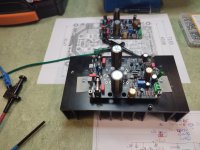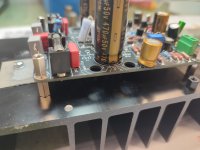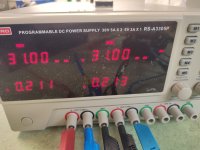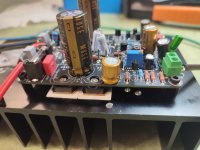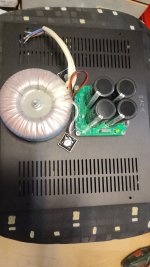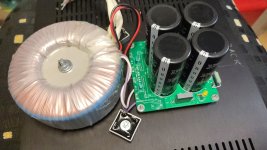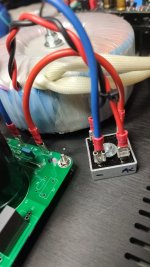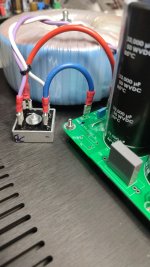i changed the pot to zero.
DC offset is 0V
R17 positive rail = - 0,288V
R22 negative rail = 0V
amp is stable at this setup.
OPV pins are stable too
😎
DC offset is 0V
R17 positive rail = - 0,288V
R22 negative rail = 0V
amp is stable at this setup.
OPV pins are stable too
😎
There is a huge thread on this, the relay is fine as long as there isn't a catastrophic failure.As your at the design stage, have you considered using solid-state relays (MOSFETs)? Its now widely held that relays won't definitely protect under all failure conditions as they can arc and become welded closed.
I.e. wandering offset and a slow failure is fine as the relay doesn't see too much current or voltage.
The problem you highlight is that a sudden 50Vdc appearing on the speaker output simply welds the relay as it can't extinguish the arc in time, so it forms a mini arc welder.
The only safe forms are:
1. Solid state MOSFET relay
or
2. Thyristor and fuse crowbar.
Obviously for start-up disconnection combined with a 'soft start' mains resistor, solution 1 is the only way 😀
However many amps start up without undue offset so option 2 remains a good idea, in my view.
ETA: If using relays, the solution is to also use 2A (etc) fuses on the power rails into the output devices, or fuse the speaker output.
I use XRK SSR...expensive but hold nearly every amp
actually no item available but try to rise the hand at this thread:
SSR by XRK and Jhofland
actually no item available but try to rise the hand at this thread:
SSR by XRK and Jhofland
Last edited:
i changed the pot to zero.
DC offset is 0V
R17 positive rail = - 0,288V
R22 negative rail = 0V
amp is stable at this setup.
OPV pins are stable too
😎
That all sounds OK up to now.
pre installation at my test heat sink...0,65K/W
no Mosfets
ps:
must change the lower stand ups to smaller one...have to order...
no Mosfets
ps:
must change the lower stand ups to smaller one...have to order...
Attachments
Last edited:
Hi
small progress....
1 channel amp is working ! 😎
i set the OPC to 230mA and was at the beginning too optimistic to set the bias to 44mV between Drain and Drain.
during warming up about 35min .... (4x 3,1WATT per MOSFET) i have to re turn the pot 3 x again, because the opc hits soft in at 225mA.
finally i plan a 3Ux 300mm housing with a SSR and a 300VA 2x 30VA trani.
no signal - because I am afraid because my Rout R26 and the coil are not installed...
will check other channel.
kr
chris
small progress....
1 channel amp is working ! 😎
i set the OPC to 230mA and was at the beginning too optimistic to set the bias to 44mV between Drain and Drain.
during warming up about 35min .... (4x 3,1WATT per MOSFET) i have to re turn the pot 3 x again, because the opc hits soft in at 225mA.
finally i plan a 3Ux 300mm housing with a SSR and a 300VA 2x 30VA trani.
no signal - because I am afraid because my Rout R26 and the coil are not installed...
will check other channel.
kr
chris
Attachments
L channel is working too...46mA each line. 👍
what about the switch on behavior? i remember that i read about 6 second is mandatory?
kr
chris
what about the switch on behavior? i remember that i read about 6 second is mandatory?
kr
chris
Hi mooly
aha...okay so i need a soft start module. a normal NTC in the primary is to weak, or?
aha...okay so i need a soft start module. a normal NTC in the primary is to weak, or?
Thanks mooly! 👍
Ah......now i understand. XRX SSR is 3 seconds if i remember right. i have to check to which value i have to set the cap/resistor.
Ah......now i understand. XRX SSR is 3 seconds if i remember right. i have to check to which value i have to set the cap/resistor.
The amplifier modules may be happy, but in my experience switching on a decent sized toroid heading straight into a bridge and capacitor bank often trips the house MCBs - so I always fit a soft start now with toroids 🙂It doesn't need any soft start
Not to hijack the thread, but tripping the fuses.... I have this '74 Marantz 2235 receiver. It was rebuilt to OEM except we did put more modern caps in the power supply.
On power on, there is a relay for the speakers... about three seconds.... but at the same time, the sucker draws enough on rush that I see even the LED lamps on the circuit dim momentarily. It's a beast of an amp.... that's the way it was built. I've always wondered if I should put a battery backed UPS on it.
On power on, there is a relay for the speakers... about three seconds.... but at the same time, the sucker draws enough on rush that I see even the LED lamps on the circuit dim momentarily. It's a beast of an amp.... that's the way it was built. I've always wondered if I should put a battery backed UPS on it.
I suppose everyone's experience varies. I used to use a 650 VA (RS) toroid with Doug Selfs blameless designs and that needed a T6.3A primary fuse but beyond that no issues.. That was oversized VA wise.The amplifier modules may be happy, but in my experience switching on a decent sized toroid heading straight into a bridge and capacitor bank often trips the house MCBs - so I always fit a soft start now with toroids 🙂
A 250 or 300VA shouldn't really pose any concerns. A T3.15 or T4A primary fuse should be all that is needed. We never had these issues historically even with large Japanese amps.
A Hoover vacuum and a VAX are the two items I have that draw a large surge and would briefly dim older household filament bulbs. All run on 32A MCB's on ring mains.
Thanks mooly! 👍
Ah......now i understand. XRX SSR is 3 seconds if i remember right. i have to check to which value i have to set the cap/resistor.
i think i found it. i wait of a confirmation of XRK per pm.
written in the thread post #747
Once it trips, it takes 2 seconds to come back on after the DC is removed. I think the timer is based on a 100k and 22uF cap. R108 and C108.
SSR by XRK and Jhofland
kr
chris
Hi Chris,
Don’t sweat the small stuff until there’s really an issue. I use those SSR boards in stock trim without any problems 😉.
Don’t sweat the small stuff until there’s really an issue. I use those SSR boards in stock trim without any problems 😉.
- Home
- Amplifiers
- Solid State
- My MOSFET amplifier designed for music
